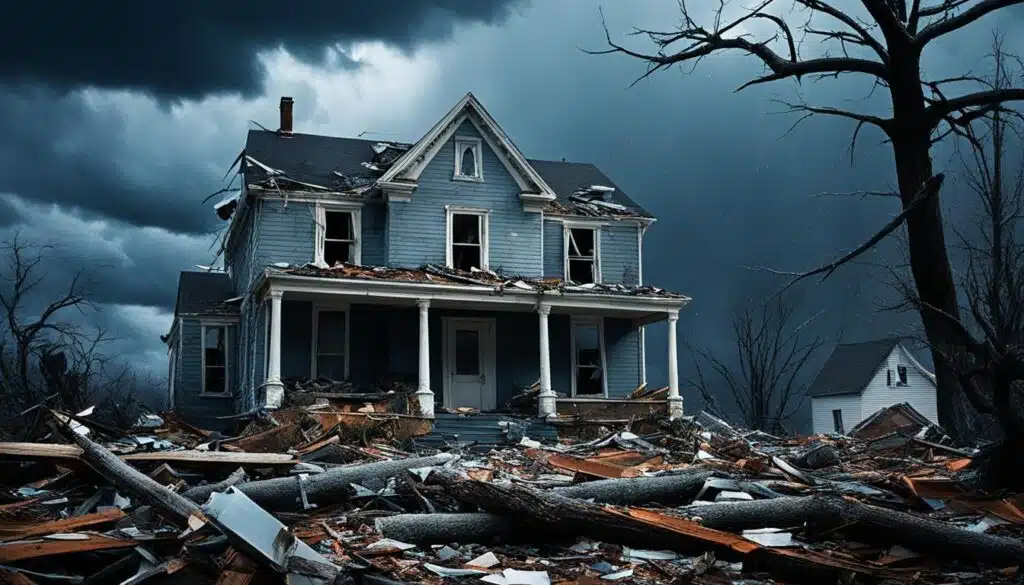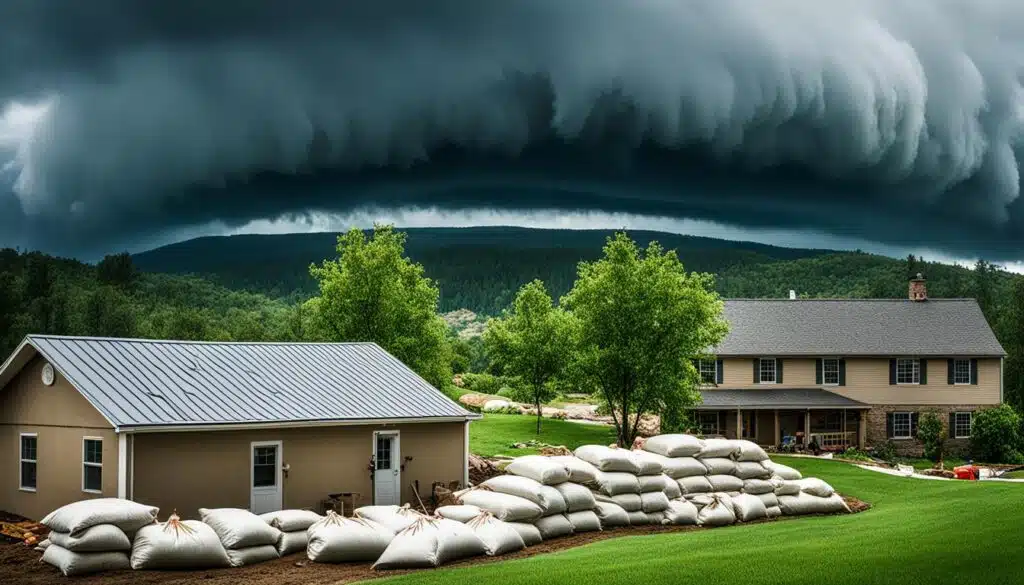When it comes to protecting your home from the devastating effects of natural disasters, having the right insurance coverage is crucial. However, recent changes in extreme weather patterns caused by climate change have prompted major insurers to adjust their policies and strategies. This has implications for homeowners insurance and other types of property insurance, as well as the overall coverage available to individuals.
Insurance companies such as Allstate, American Family, Nationwide, Erie Insurance Group, and Berkshire Hathaway have made significant policy changes in response to the increasing risk of natural disasters. These changes include stopping coverage in some regions, excluding protections from certain weather events, and raising premiums and deductibles for homeowners insurance policies.
As a homeowner or property owner, it’s important to stay informed about these changes and evaluate your insurance options to ensure you have adequate coverage for natural disasters. Let’s explore the impact of climate change on insurance coverage and the strategies insurers are implementing to mitigate risks.
Key Takeaways:
- Natural disaster property insurance is essential for homeowners and property owners to protect against the risks posed by climate change and extreme weather events.
- Major insurers have adjusted their policies due to increasing risks, resulting in changes to coverage, premiums, and deductibles.
- Homeowners should review their insurance policies regularly and consider additional coverage, such as flood insurance or earthquake insurance, to fill potential gaps.
- Insurance companies have implemented diverse strategies, including limiting new business in high-risk areas and updating policy terms, to address climate change risks.
- Promoting diversity, equity, and inclusion in disaster planning and response efforts is crucial to ensure equitable support for all communities in times of crisis.
The Impact of Climate Change on Insurance Coverage
The effects of climate change have led to an increased risk of natural disasters, such as hurricanes, wildfires, and flooding. These extreme weather events have forced insurance companies to reevaluate their coverage and policy terms to adequately protect homeowners. While homeowners insurance policies typically cover a range of perils, there may be certain natural disasters that are not covered by standard policies.
Homeowners insurance policies generally cover:
- Fire damage
- Theft
- Vandalism
- Liability
However, they may not include coverage for disasters like:
- Floods
- Earthquakes
- Hurricanes
In scenarios where natural disasters are not covered by homeowners insurance, homeowners may need to obtain a separate policy or endorsement to ensure adequate coverage. For example, flood insurance policies are separate from standard homeowners insurance and provide coverage specifically for flood-related damages.
Note: Some insurance providers offer additional endorsements to enhance coverage for natural disasters, such as earthquake endorsements for areas prone to earthquakes.
It’s essential for homeowners to thoroughly review their insurance policies to understand their coverage and identify any potential gaps in protection. They should also consider investing in additional policies or endorsements to secure the necessary coverage for natural disasters.
“Being aware of the coverage provided by your homeowners insurance policy is crucial in ensuring financial protection in the event of a natural disaster.”
Comparison of Coverage for Natural Disasters
| Disaster Type | Homeowners Insurance Coverage | Separate Policy/Endorsement Required |
|---|---|---|
| Floods | No | Yes |
| Earthquakes | No | Yes |
| Hurricanes | Varies | Varies |
The table above provides a comparison of coverage for different natural disasters in homeowners insurance policies. It is important to consult with your insurance provider or agent to understand the specific coverage options available for your area and evaluate whether additional policies or endorsements are necessary.
Insurance Industry Responses to Climate Change Risks
Insurance providers have implemented various strategies to address the increased risks associated with climate change. These initiatives aim to ensure that individuals have adequate coverage for natural disasters. Some of the key responses from the insurance industry include:
- Limiting new business in areas most exposed to hurricanes: Insurance providers are cautious about underwriting policies in regions prone to hurricanes. This helps minimize potential losses and allows companies to manage risks effectively.
- Implementing deductibles or exclusions for tropical cyclones and wind/hail damage: Insurers often modify policy terms to account for higher risks. By implementing deductibles or exclusions specifically related to tropical cyclones and wind/hail damage, insurance companies can better manage claims in the event of a natural disaster.
- Updating policy terms to reflect changes in risk: As climate change leads to shifting patterns in natural disasters, insurance providers update their policy terms to accurately reflect the evolving risks. These updates may include changes in coverage limits, definitions of natural disasters, or the addition of optional coverages.
- Stopping underwriting coverage for properties within a certain distance to the coastline: Some insurers have decided to cease underwriting coverage for properties located in close proximity to the coastline due to the potential impact of hurricanes. This measure is designed to mitigate risks associated with coastal areas prone to storm surges and high wind speeds.
Consulting with insurance agents is crucial to ensure individuals have appropriate coverage for natural disasters. Insurance agents can provide valuable guidance on the types of insurance available, such as separate policies specifically designed to cover natural disasters. They can also help individuals understand the terms and conditions of their insurance policies and identify any potential gaps in coverage.
By staying informed about the insurance industry’s responses to climate change risks, individuals can make informed decisions to protect themselves and their properties from the impacts of natural disasters.
Insurance Industry Responses to Climate Change Risks
| Insurance Industry Response | Description |
|---|---|
| Limiting new business in high-risk areas | Avoiding or reducing underwriting coverage for properties located in regions exposed to hurricanes or other natural disasters. |
| Deductibles or exclusions for specific risks | Modifying policy terms to include deductibles or exclusions specifically related to tropical cyclones, wind/hail damage, or other natural disasters. |
| Updating policy terms | Revising policy terms to accurately reflect the changing risks associated with climate change and natural disasters. |
| Stopping underwriting in coastal areas | Ceasing underwriting coverage for properties within a certain distance to the coastline due to the heightened risk of hurricanes and storm surges. |
Note: The table above highlights some of the key responses from the insurance industry. This is not an exhaustive list, and insurance providers may employ various other strategies to address climate change risks.
Rising Costs and Losses for Insurers
The increasing frequency and severity of natural disasters have resulted in rising costs and losses for insurers. Over the past few years, the insurance industry has disbursed billions of dollars in claims for natural disasters, experiencing record-breaking losses. In response to these financial challenges, insurers are implementing measures to mitigate their risks and ensure their long-term sustainability.
As a consequence of the escalating costs, insurance rates have been on the rise. To cover the losses and maintain profitability, insurers have been compelled to increase premiums and deductibles across various types of insurance policies. These adjustments reflect the higher risks associated with natural disasters, as insurers seek to adequately protect themselves while continuing to provide essential coverage to policyholders.
One aspect that individuals should consider in light of these developments is the coverage for natural disasters provided by their existing insurance policies. Standard homeowners or renters insurance policies may not provide comprehensive coverage for damages caused by natural disasters. Certain disasters, such as floods or earthquakes, are typically not covered under these policies, leaving policyholders vulnerable to significant financial losses in the event of such occurrences.
Separate insurance policies, such as flood insurance or disaster insurance, should be seriously considered to bridge this coverage gap. These specialized policies can provide additional protection and financial assistance to individuals and families in the unfortunate event of their properties being damaged in a natural disaster. Renters insurance, too, can offer valuable coverage for personal belongings in the event of a disaster.
Insurance Coverage for Natural Disasters
| Insurance Type | Coverage |
|---|---|
| Homeowners Insurance | Generally does not cover floods, earthquakes, or other natural disasters. Additional policies or endorsements may be necessary. |
| Renters Insurance | Provides coverage for personal belongings in the event of a disaster, including damage caused by natural disasters. |
| Flood Insurance | Specifically covers damages caused by floods, which are not typically covered by standard homeowners insurance. |
| Disaster Insurance | Offers comprehensive coverage for a range of natural disasters, ensuring financial protection for property owners. |
By understanding the limitations of their existing insurance coverage and taking proactive steps to complement it with separate policies tailored for natural disasters, individuals can ensure they are adequately protected in the face of these unpredictable events. It is essential to review insurance policies regularly, evaluate the risks specific to your region, and consult with insurance professionals to make informed decisions about the best coverage options for your needs.

The Importance of Diversity, Equity, and Inclusion in Disaster Planning
Disasters have a way of magnifying existing inequalities and injustices faced by marginalized communities. Racial and ethnic minority groups, as well as individuals with low incomes, are particularly vulnerable to the devastating effects of these events. Historical injustices and limited access to resources have further compounded their susceptibility to disasters. Therefore, it is imperative to prioritize diversity, equity, and inclusion (DEI) in disaster planning to ensure that all communities receive equal support and have a fair chance at recovery.
DEI initiatives in disaster planning can help address the systemic and environmental injustices that have perpetuated disparities in vulnerable communities. By taking into account the unique needs and circumstances of racial and ethnic minority groups and individuals with low incomes, disaster planning can be more effective and equitable.
One way to promote DEI in disaster planning is through inclusive decision-making processes. By involving representatives from diverse communities and ensuring their voices are heard, planners can gain valuable insights into the challenges and specific requirements of these groups. This collaboration can help identify and implement targeted strategies that address the unique vulnerabilities and needs of marginalized communities.
Another crucial aspect of DEI in disaster planning is the equitable distribution of resources and aid. Often, marginalized communities lack access to critical resources, such as emergency shelters, healthcare facilities, and transportation options. Through intentional planning and coordination, disaster response efforts can ensure that these communities have equal access to these resources, which are essential for their safety and recovery.
“Diversity, equity, and inclusion are not simply buzzwords, but vital components of effective disaster planning,” says Dr. Jessica Thompson, a disaster management expert. “By centering our planning efforts around these principles, we can create more resilient and equitable communities in the face of disasters.”
| Diversity in Disaster Planning | Equity in Disaster Planning | Inclusion in Disaster Planning |
|---|---|---|
| Representation of diverse communities in decision-making processes | Equitable distribution of resources and aid | Ensuring access and consideration for all individuals and communities |
| Engaging community leaders and organizations | Addressing systemic and environmental injustices | Creating a sense of belonging and empowerment |
| Promoting cultural competency and understanding | Recognizing and addressing historic disparities | Encouraging participation and engagement |
By prioritizing diversity, equity, and inclusion in disaster planning, we can work towards a more just and resilient society. It is essential for governments, policymakers, and community leaders to collaborate in these efforts and ensure that no community is left behind in disaster preparedness and response.

External DEI Best Practices in Disaster Response
When it comes to disaster response, it’s crucial to prioritize diversity, equity, and inclusion (DEI) efforts. External DEI strategies should lead with humility and aim to understand the trauma and historical experiences of the communities being served. Building trust with communities of color and marginalized groups is essential for effective disaster response. Here are some best practices to consider:
- Establish a Presence: Engage with local leaders and establish a presence in the community. This will help foster trust and create opportunities for meaningful collaboration.
- Lead with Humility: Acknowledge the unique challenges faced by multicultural populations and approach disaster response with humility. Recognize the expertise and insights of the communities you serve.
- Tailored Outreach Strategies: Develop outreach strategies that effectively communicate with multicultural populations. This can include a mix of communications channels such as handouts, social media, radio, and print media ads.
- Engage Local Leaders: Collaborate with local leaders and organizations to gain a deeper understanding of the specific needs and priorities of the community. Their insights can inform more targeted disaster response efforts.
Effective disaster response requires a commitment to understanding and addressing the unique needs of diverse communities. By prioritizing DEI efforts, building trust, and implementing tailored outreach strategies, we can ensure that disaster response is inclusive and supportive of all populations.

Internal DEI Best Practices in Disaster Planning
Developing internal diversity, equity, and inclusion (DEI) strategies is crucial for organizations in effectively serving diverse populations during disaster planning. By implementing the following best practices, organizations can foster an inclusive and equitable environment:
- Measure Efforts and Set Goals: Organizations should measure the effectiveness of their DEI initiatives and set clear goals for improvement. Key performance indicators can help track progress and identify areas for further development.
- Attract and Recruit Diverse Talent: Promoting diversity starts with attracting and recruiting a diverse workforce. Reviewing recruitment practices, establishing inclusive hiring processes, and partnering with diverse talent pipelines can help organizations build a diverse team.
- Prioritize Learning and Development: Prioritizing learning and development opportunities on DEI topics is essential for fostering a culture of inclusion. By providing training, workshops, and educational resources, organizations can empower employees to understand and address diverse perspectives and needs.
- Engage Employee Resource Groups: Employee resource groups (ERGs) play a valuable role in promoting DEI efforts within organizations. Encouraging employees to form ERGs dedicated to specific diversity dimensions can provide a platform for collaboration, knowledge sharing, and advocacy.
Implementing these best practices helps organizations cultivate a culture of diversity and inclusion, enabling them to better meet the needs of diverse communities during times of disaster.
Quote:
“Fostering diversity, equity, and inclusion internally strengthens organizations’ ability to serve diverse communities during disaster planning.” – [Author Name], DEI Specialist

| Best Practices | Examples |
|---|---|
| Measuring Efforts and Setting Goals | Establishing a DEI scorecard with targets for representation and inclusion |
| Attracting and Recruiting Diverse Talent | Partnering with organizations focused on diverse talent pipelines |
| Prioritizing Learning and Development | Offering DEI training and workshops for employees at all levels |
| Engaging Employee Resource Groups | Supporting ERGs focused on dimensions such as race, gender, or LGBTQ+ |
Understanding Insurance Terms and Coverage
When evaluating insurance coverage for natural disasters, it is crucial to have a clear understanding of basic insurance terms. Terms like premium, deductible, and coverage play a significant role in determining the cost of insurance and the extent of protection provided.
Premium: The premium is the amount you pay for insurance coverage. It can be paid monthly, quarterly, or annually and varies based on factors such as the value of your property, location, and the level of coverage you need.
Deductible: The deductible is the amount you are responsible for paying out of pocket before your insurance coverage kicks in. For example, if you have a $1,000 deductible and your claim is $5,000, you will pay the first $1,000, and your insurance company will cover the remaining $4,000.
Coverage: Insurance coverage refers to the specific risks and perils that are included in your policy. Property insurance, which includes homeowners insurance and renters insurance, typically covers damage to structures and personal belongings caused by events like fire, theft, and weather-related incidents.
It is crucial to review your insurance policies annually to ensure that your coverage adequately protects you against natural disasters. Consider any changes in your property’s inventory and value and assess whether your current coverage is sufficient.
Types of Property Insurance
| Type of Insurance | Definition |
|---|---|
| Homeowners Insurance | Insurance coverage for homeowners that protects against property damage, theft, and personal liability. |
| Renters Insurance | Insurance coverage for renters that protects personal belongings and provides liability coverage. |

By understanding insurance terms and carefully reviewing your policies, you can ensure that you have the appropriate coverage to protect you and your property in the event of a natural disaster.
Federal Aid for Disaster Recovery
In the aftermath of a natural disaster, individuals may find themselves in need of financial help to recover and rebuild. While insurance coverage is often the first line of defense, federal aid can provide additional assistance in certain circumstances.
Federal aid, also known as federal disaster aid or federal assistance, is a program that offers financial support to individuals, businesses, and communities affected by major disasters. This aid is provided by the federal government and can help cover costs not covered by insurance or other sources.
However, it’s important to note that federal aid is not automatically available in all situations. It is only provided when the president declares a major disaster in a specific area. This declaration is typically made when the scale and severity of the disaster exceed the capabilities of state and local resources.
Once a major disaster is declared, federal aid may be available to help individuals and communities recover and rebuild. This assistance can include grants, low-interest loans, temporary housing, and other forms of financial support. However, it’s important to keep in mind that federal aid may not cover all costs and may require repayment in some cases.
When considering federal aid, individuals should assess their insurance coverage and determine if it falls short or is insufficient to cover their needs. It’s also important to understand that federal aid is intended to supplement insurance and other resources, not replace them.
Also Read:- Understanding Business Property Insurance Costs And Optimization Strategies
Taking the time to understand the process and requirements for federal aid can help individuals navigate the recovery process more effectively. This may include documenting losses, filing insurance claims, and submitting applications for federal assistance.
In summary, federal aid can provide much-needed financial help to individuals and communities affected by major disasters. However, it is important to assess insurance coverage and other resources before relying solely on federal aid. By understanding the availability and limitations of federal assistance, individuals can make more informed decisions and contribute to a smoother recovery process.
| Type of Federal Aid | Description |
|---|---|
| Grants | Financial assistance that does not need to be repaid. Grants are often provided to help cover temporary housing, home repairs, and other disaster-related expenses. |
| Low-Interest Loans | Loans with favorable interest rates that can help individuals and businesses rebuild and recover. These loans are typically provided by the Small Business Administration (SBA) and other agencies. |
| Temporary Housing | Assistance in the form of temporary housing for individuals displaced by a disaster. This may include rental assistance, hotel vouchers, or other forms of short-term housing. |
| Other Financial Support | Additional forms of financial assistance may be available depending on the specific needs and circumstances of the disaster. This can include funding for infrastructure repairs, community development projects, and more. |
Steps to Take Before a Disaster
Before a disaster occurs, it is crucial to take proactive steps to ensure you are adequately prepared. One essential aspect of disaster preparedness is shopping for insurance coverage that includes protection against natural disasters. Waiting until the last minute to purchase insurance may leave you without coverage when you need it most. By taking the time to shop for insurance ahead of time, you can have peace of mind knowing that you are financially protected in the event of a disaster.
Here are some important steps to take before a disaster:
- Insurance Shopping: Research and compare different insurance providers to find the best coverage options for natural disasters such as floods, earthquakes, or other relevant perils. Consider factors such as policy terms, coverage limits, premiums, and deductibles to choose a suitable insurance policy.
- Creating a Home Inventory: Make a detailed inventory of your belongings and property. Keep a record of important information such as purchase dates, descriptions, and values. This inventory will be useful for insurance claims in case of damage or loss during a disaster.
- Storing Inventory and Important Documents Securely: Safeguard your home inventory and important documents in a secure location. Consider using a fireproof and waterproof safe or storing digital copies in the cloud for easy access.
- Insurance Policy Review: Regularly review your insurance policies, including homeowners or renters insurance, to ensure you have adequate coverage for natural disasters. Review any policy updates or changes in coverage limits to assess if adjustments are needed to align with your current needs.
It is always better to be prepared before a disaster strikes. By taking these steps, you can ensure you have the necessary insurance coverage and documentation to navigate the aftermath of a disaster more smoothly.
Being proactive in your disaster preparedness can make a significant difference in minimizing the financial impact of a natural disaster. By shopping for insurance, creating a comprehensive home inventory, securely storing important documents, and regularly reviewing your insurance policies, you can better protect yourself and your property in the face of unexpected events.
Steps to Take After a Disaster
After experiencing a disaster, it is crucial for individuals to take immediate action to begin the recovery process. One of the first steps is to submit an insurance claim to your insurance provider for assistance in repairing or replacing damaged property. To ensure a smooth claim process and maximize your chances of receiving the financial assistance you are entitled to, follow these important steps:
- Document the Damage: Before making any repairs or cleaning up, be sure to document the extent of the damage. Take photographs or videos of the affected areas and make notes of any valuable items that have been lost or damaged.
- Contact Your Insurance Provider: Reach out to your insurance company as soon as possible to report the damage and initiate the claim process. They will guide you through the necessary steps and provide you with the required documentation.
- Provide Documentation: Gather all relevant documents to support your claim, including photographs, videos, receipts, and any other evidence of ownership or value of the damaged items. Submit these documents to your insurance provider as instructed.
- Review Your Insurance Policies: Take the time to carefully review your insurance policies to understand the coverage and deductible amounts for the type of damage you have incurred. This will help you assess what expenses may be covered and what costs you may be responsible for.
- Keep a Home Inventory: Having a detailed inventory of your personal belongings can significantly streamline the claim process. If you have already created a home inventory, use it to assist in documenting the damaged items. If you do not have one, consider starting one as soon as possible for future reference.
- Follow Proper Document Storage Practices: Keep all copies of your claim-related documents, including communication with your insurance provider, in a safe and easily accessible place. This will help you stay organized and provide evidence of your claim in case of any disputes or additional requests.
By following these steps, you can ensure that you are well-prepared and organized throughout the claim process, increasing your chances of receiving the necessary financial assistance to recover from the disaster.
“Documenting the extent of the damage and providing thorough documentation to your insurance company are essential steps in the claim process after a disaster.”
| Important Steps to Take After a Disaster |
Key Takeaways |
|---|---|
| Document the Damage | By documenting the extent of the damage with photographs, videos, and notes, you provide evidence to support your claim. |
| Contact Your Insurance Provider | Reporting the damage to your insurance company as soon as possible ensures that the claim process begins promptly. |
| Provide Documentation | Submit all relevant documents, such as photographs, videos, receipts, and evidence of ownership or value, to strengthen your claim. |
| Review Your Insurance Policies | Understanding the coverage and deductible amounts specified in your insurance policies helps you assess what expenses may be covered. |
| Keep a Home Inventory | A detailed inventory of your personal belongings simplifies the process of documenting damaged items and their value. |
| Follow Proper Document Storage Practices | Properly storing all claim-related documents, including communication with your insurance provider, ensures easy access and organization. |
Conclusion
Natural disasters pose significant risks to homeowners and renters, emphasizing the need for comprehensive insurance coverage. As climate change continues to impact extreme weather patterns, insurance companies are adapting their policies to mitigate related risks. It is crucial for individuals to have a clear understanding of their insurance coverage and any potential gaps in protection for natural disasters.
In addition to insurance coverage, diversity and inclusion play a vital role in effective disaster planning and response efforts. Marginalized communities, including racial and ethnic minority groups and low-income households, are disproportionately affected by disasters due to historical injustices and limited access to resources. By prioritizing diversity and inclusion, communities can ensure that all individuals receive equitable support and have equal access to resources and recovery efforts.
Preparing for natural disasters requires proactive steps, such as evaluating insurance options and understanding policy terms. It is essential for homeowners and renters to regularly review their insurance policies to ensure they have adequate coverage. By taking these precautions and promoting diversity and inclusion in disaster planning, individuals can better safeguard their homes and communities against the impacts of natural disasters.
FAQs
Q: What is natural disaster property insurance?
A: Natural disaster property insurance provides coverage for damages caused by natural disasters such as earthquakes, floods, hurricanes, and wildfires.
Q: Does standard home insurance cover natural disasters?
A: Standard home insurance policies typically do not cover natural disasters such as earthquakes, floods, and hurricanes. Specialized insurance policies or riders are required for coverage.
Q: What types of disasters are covered by homeowners insurance?
A: Homeowners insurance typically covers disasters such as fire, lightning, windstorms, and hail. However, coverage for earthquakes, floods, and hurricanes may not be included and may require additional policies.
Q: Do I need separate earthquake insurance?
A: Yes, if you live in an area prone to earthquakes, it is advisable to purchase separate earthquake insurance as standard home insurance policies do not cover earthquake damages.
Q: What is disaster insurance?
A: Disaster insurance provides coverage for damages caused by natural disasters such as floods, hurricanes, tornadoes, and earthquakes. It is designed to help homeowners and renters recover from the financial impact of such events.
Q: Is there insurance specifically for natural disasters?
A: Yes, there are specialized insurance policies designed to cover damages and losses resulting from natural disasters. These policies provide coverage for events like earthquakes, floods, hurricanes, and wildfires.
Q: What type of coverage does home insurance offer for natural disasters?
A: Home insurance typically offers coverage for standard disasters like fire, windstorms, and hail. Additional coverage for natural disasters such as earthquakes and floods may need to be purchased separately.
Q: How can I get sewer backup insurance for my home?
A: Sewer backup insurance can usually be added as an endorsement to your existing homeowners insurance policy. Contact your insurance agent to inquire about adding this coverage to your policy.
Q: Where can I find information about insurance for natural disasters?
A: Information about insurance for natural disasters can be obtained from licensed insurance agents, insurance companies, and reputable sources such as the Insurance Information Institute or the insurance editorial section of Bankrate.
Q: Should I buy separate flood insurance if I already have home insurance?
A: If you live in an area prone to flooding, it is recommended to purchase separate flood insurance in addition to your standard home insurance, as most home insurance policies do not cover flood damage.




